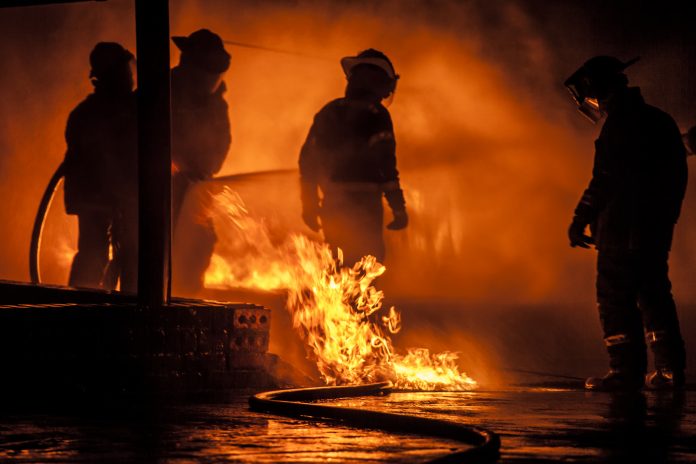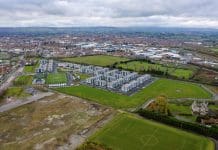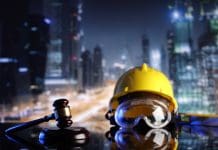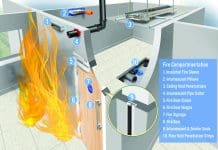Ian King, chief operating officer at Zeroignition, takes a look at how fire safety in the construction industry is being propelled to the top of the agenda
Having been at best an afterthought for far too long, the government focus on building safety with forthcoming new regulations, including a new fire safety bill, is welcome.
As demand for UK housing continues to grow, the current system is under pressure. Planning departments are poorly staffed, and building control under-resourced, creating a bottleneck in planning approvals. This means compressed project timelines and the need to complete builds in unrealistic time frames.
A focus on delivering high volumes of housing quickly and as cost-effectively as possible coupled with skills and labour shortages results in builds with errors not being spotted or addressed.
Furthermore, the culture of specification is breaking down – we have a toxic culture where products are substituted primarily on cost, often without checking performance and safety criteria, and frequently without sign off). The scale of this was revealed by the recent Construction Product Association report.
These factors act together, increasing the likelihood of serious mistakes.
The industry seems to have lost touch with the fact they are building peoples’ homes. As Matthew Carmona, from Bartlett School of Planning stated, the industry “are putting profit before anything else.” I agree, and understand, that while there’s a need for businesses to make money, safety is an area that has been overlooked. There’s also been no clear desire for change within the industry.
Change in regulations
New regulations which have arisen following Grenfell, are imminent. My worry is regulation alone will not combat the systemic problems construction harbours.
The UK needs to enforce punitive sanctions, coupled with a well-resourced inspection regime which catches all those cutting corners, largely due to the construction industry’s fragmented nature.
I want to understand how the government plans to make the industry adhere to these regulations, and I’ve no doubt this will be particularly challenging. Positive regulation of safety is great, but only if it is policed.
In my view, the new regulator and its inspectors will not have the manpower to investigate and eradicate all bad practice out there. Construction urgently needs to change its culture and practices voluntarily, but that is just wishful thinking.
At the NBS’ Construction Product Leaders’ Summit in February, this year (2020) Dame Judith Hackitt expressed it like this: “people are playing games with the system,” with profit margins prioritised over protecting lives.
How should the industry be improving?
Fire safety considered holistically throughout a project, review, and sign off on buildings, must be rigorous and include the client, designers, and contractors. There need to be clearly defined fire safety roles at each work stage from the strategic definition of the project through briefing, design, construction, handover, and occupancy. This approach needs to become standard practice before the regulation comes into force. Lives depend on it.
A focus on education and upskilling. There are still severe gaps in many construction professionals’ knowledge. The industry shouldn’t have to wait for laws to change, people need to challenge themselves to know more and incorporate it into their everyday work. Last year we conducted some research across the UK, Germany and France which revealed that knowledge levels surrounding fire and fire protection amongst some of our most trained professionals are very low.
Across the three countries, only 3% of architects were able to correctly define the four basic fire protection terms: active fire protection, passive fire protection, fire resistance and reaction to fire. While a mere 2% of architects interviewed said they’d had comprehensive fire protection training. Recent evidence at the Grenfell inquiry fully supports this view. It is clear the industry has inadequate knowledge-making ongoing career-long training mandatory for all construction professions.
Developing a systematic approach. Let’s stop seeing individual building products and start recognising an overall system. Tragedies, including Grenfell, weren’t caused by a single item or one poor decision. Failure is fundamentally a combination of products, people and practice. A building is much more than a sum of its parts. At every stage we need to ensure a focus on the site-specific end result with fire protection built-in. Ultimately, we’re creating a safe place for people to live.
The industry also needs to see:
Improved building control and meticulous site inspections completed on every new build. Each construction project should be treated on a site-by-site basis to ensure no corners are cut, standards must be fixed in place to ensure the end-user can live there safely.
A robust and realistic testing regime. As Hackitt stated, “we need to address the many problems in the way products are tested, placed and substituted in an ill-disciplined, poorly reasoned way.” Taking a systematic design approach still involves the specification of individual components required during the construction process. While each element must be individually fire tested, the testing regime needs to be built out. Products used need to be tested in groups and mimic real-life scenarios.
The days of manufacturers marking their own homework must end. Certification should only be granted by independent third-party bodies and involve the input of fire experts, including building control bodies and the fire and rescue authorities to ensure corners have not been cut. Both should have a statutory role at the design and planning stages. Too often their advice is not sought or ignored. This approach is folly yet all too common. There also needs to be auditing and spot inspections to check items still perform as certified.
Safety must come first, every time
When a large number of people are affected by one tragedy it creates a policymaking challenge. High profile events mean the government has to be seen to react, this can result in kneejerk legislation without thinking through the consequences.
It’s essential all buildings are appropriately protected from fire. While fire regulations are strict for those building houses for large numbers of people or vulnerable individuals, the vast majority of us live in homes where fire regulation is weakest. This is to the extent that a single dwelling may have almost no regulations at all.
Regulation is coming. However, this needs to be coupled with an enforced focus on professional education, improved testing regimes, better internal auditing and site checks to ensure homes match the quality expected.
Although progress is slow, it’s promising to see people are beginning to recognise that combining product knowledge, fire-safe system design, and an acknowledgement of how they integrate, is essential to building better and safer homes.
This isn’t about box-ticking, fire safety is about saving lives.

Ian King
Chief operating officer








![[Video] Enhancing safety with fire doors: A case study of Marina Care Home](https://www.pbctoday.co.uk/news/wp-content/uploads/2025/06/maxresdefault-218x150.jpg)





